#exit polls 2023
Text

Narsinghpur Madhya Pradesh Assembly Election Results 2023 Live: Can BJP Score a Hat Trick of Victory in Narsinghpur? Early trends will follow soon.
https://techmagone.com/narsinghgarh-madhya-pradesh-assembly-election-results-2023-live/
exitpoll2023
electionresults
rajasthanelection2023
telanganaelection
exitpolls
telanganaelection2023
electionresults2023
exitpoll
telanganaelectionresults
rajasthanexitpoll
telangana
revanthreddy
mp election2023
kcr
electionresultsdate
chhattisgarh
brsparty
electionresult2023
exitpolls2023
rajasthanopinionpoll2023
mpexitpoll
madhyapradeshelection2023
electionresultslive
brsfullform
mizoram
#exit poll 2023#election results#rajasthan election 2023#telangana election#exit polls#telangana election 2023#election results 2023#exit poll#telangana election results#rajasthan exit poll#telangana#revanth reddy#mp election 2023#kcr#election results date#chhattisgarh#brs party#election result 2023#exit polls 2023#rajasthan opinion poll 2023#mp exit poll#madhya pradesh election 2023#election results live#brs full form#mizoram
0 notes
Text
Telangana Election 2023 - 20.64% Turnout, Disturbance in Rangareddy"
Telangana Election 2023: Battle for 119 Seats as BRS and Congress Vie for Supremacy
Commencing on Thursday, November 30, the electoral battleground in Telangana witnessed a fierce competition across its 119 seats, primarily dominated by a close contest between the Bharat Rashtra Samiti (BRS) and the Congress.
While the Bharatiya Janata Party (BJP) seeks to expand its influence in the state,…

View On WordPress
#exit polls 2023#Telanagana Exit Polls 2023#telangana assembly elections 2023\#telangana elections 2023#Telangana elections 2023 date
0 notes
Text
The exit poll of the Dutch elections is very disheartening.
#dutch elections 2023#dutch politics#the fucking pvv being the biggest in the exit poll is shameful#for context the leader if the pvv (geert wilders) is the guy that wants to straight up ban the quran#fuck it all#at least gl-pvda is the second largest#it looks like we might get a very right-wing government#although it's still possible for a more left leaning coalition to be formed#I'm not very optimistic about that though#kind of depends on the vvd and nsc realistically#verkiezingen#tweede kamer verkiezingen
17 notes
·
View notes
Text
Finland Win The Grand Final's Eurovision Audience Poll
Finland Win The Grand Final's Eurovision Audience Poll
The Eurovision Audience poll is a collaboration between ESCXTRA.com, ESC Insight, The EuroTrip Podcast and BetEurovision. Volunteers asked the audience as they left the Liverpool Arena one question… “what was your favourite act?” These are the results.
Eurovision Audience Poll, Grand Final, 2023
Find out more at www.eurovisionaudiencepoll.com.

View On WordPress
2 notes
·
View notes
Text
Exit Polls analysis
The just concluded State Assembly Elections to Chattisgarh, Madhya Pradesh, Mizoram, Rajasthan, and Telangana have thrown a confusing trend for analysts. Most of the exit pollsters are a confused lot along with most television channels. Tomorrow, 3rd December 2023 will tell how accurate these agencies & TV chanels who conducted the exit polls.
About 2 to 3 months back, no one expected BJP to make any kind of come back to power in Chattisgarh and Madhya Pradesh. Rajasthan was the only state, where BJP have a definite edge because they decided not to project former CM Vasundhara Raje as the Chief Ministerial candidate because of which they lost the 2018 elections to the state assembly.
On 30th November, 2023 Telangana went to polls, and which was the day when Exit poll results allowed. All the exit pollsters looked a confused lot. Their estimates clearly tell that they are not telling the truth or they are confused. Most of them put out a wide range for BJP and INC, two main contenders for power.
Chattisgarh is a closely contested election with INC having a decisive edge about a month back. As the second phase of the elections started, BJP seems to have caught up with them and now the final numbers will be so close that it is a close call for both parties. BJP will win around 39 seats (+/- 3) and INC 47 seats (+/_ 5).
In Madhya Pradesh, BJP initially was lagging behind. Once the election bugle was sounded Chief Minister Shivraj Singh Chouhan took the opposition party, INC head on and now they seem to be in the driver's seat. Here too the election is very closely contested. The final tally for BJP is around 120-126 seats and INC 97-103. The possibility of BJP ending with a higher tally is extremely high.
In Rajasthan, BJP will win 120 or more. Voters have decided to teach INC a lesson of their lifetime. INC may end up with 65-70 seats. Here BJP is getting a clear mandate.
Telangana BRS holds the key as they are in power and have a key ally in AIMIM who will not ditch them. INC has made big inroads into BRS's muslim vote bank. That is a worrying factor for AIMIM who has no influence outside Hyderabad. AIMIM will remain a 3% vote share party, not beyond it. BJP is a minor player who increased its vote share to 14% from 2018's 7%. This should worry BRS. If BRS wins 50-55 seats, then they have to reach out to BJP apart from AIMIM who is their traditional ally since the formation of Telangana state in 2013. Wondering how BJP & AIMIM will be part of the same alliance? Will AIMIM walk out of the alliance with BRS? Anything can happen.
In MP and Rajasthan, exit pollsters gave a wide range of 20-30 seats. That means either they are confused or they did not do their work diligently. In Mizoram, they have projected a 6 seats range for the local party in an assembly of 40 seats. That is ridiculous.
BJP will win Madhya Pradesh and Rajasthan. In Rajasthan, they will win hands down, and in Madhya Pradesh, it is a closely contested fight with BJP having a big edge now. Chattisgarh turned into a nail-biting contest; it can go either way. Telangana is also a closely contested election with BRS losing a lot but staking claim to power with the support of other two parties - AIMIM & BJP. INC gained a lot in this election, bringing them close to power in the state after 10 long years.
1 note
·
View note
Text
Deze exit polls van de verkiezingen 😭😭
1 note
·
View note
Text

(ID in alt)
Hello Tumblr! I am posting this on behalf of the Queer Liberation Library, who don't yet have a Tumblr, but have promised me they're working on it. Some of you may remember them from the Twitter Poll I was involved in a few months ago where Hunger Pangs: True Love Bites beat multiple award-winning, trad-pub queer authors with a hefty 69% (nice).
For those of you unaware, the Queer Liberation Library, or QLL, is an organization fighting to build a vibrant, flourishing queer future by connecting LGBTQ+ people with literature, information, and resources that celebrate the unique and empowering diversity of our community.
And today, June 12th, 2023, they launched their fundraiser to try and reach 15k so that they can start purchasing digital licensing for queer media and hopefully open their digital doors to library patrons across the US in 2023 with as many queer and trans books as possible.
You can check out their newly redesigned website here:
(If you are in an unsafe space and need to exit the webpage quickly, there is a quick exit bar at the top that redirects to a weather page. When I spoke to them about their web design they were also open to accessibility suggestions and are potentially working on a dark mode for those of us who need it.)
If you know me, you know I am unequivocally pro-library, both as a reader and a queer writer. But with the current rise of homophobia, transphobia, and the proposed ban on books taking hold in certain States, the importance of having protected access queer books cannot be over-emphasized enough.
The QLL aims to protect that access, aiming to provide FREE access to queer and trans media (ebook and audio) to patrons regardless of location within the United States.
They are funded entirely through regular donations from their supporters and their now annual Pride fundraiser, where they hope to afford the cost of not just library books but also maintaining their web presence and staff.
I cannot emphasize enough how much this project is a labor of love for everyone involved and its importance.
And just to clarify, I am not involved in any way beyond raising awareness. When QLL reached out and asked me to retweet their fundraiser tweets, I readily agreed and offered to post about it on Tumblr because I believe in their mission and the world they are trying to build.
One where queer and trans books can't be banned or taken off of shelves because of bigotry and hatred.
If you would like to donate to the cause, you can do so here:
They've already surpassed their first 2k, and it'd be absolutely wonderful if we could help them reach their next milestone. And if you can't give, please consider signal boosting this post.
You can also follow QLL at:
Twitter: @queerliblib
Instagram: @queerliblib
Tiktok: @queerliblib
4K notes
·
View notes
Text
"New Mexico will establish a permanent absentee voter list and remove barriers to voting on tribal lands under sweeping legislation signed into law Thursday [March 30, 2023] by Gov. Michelle Lujan Grisham.
The measure also will automate voter registration during certain Motor Vehicle Division transactions and more quickly restore the voting rights of people exiting prison after a felony conviction. It was supported this year by Democratic legislative leaders and Lujan Grisham, a Democrat, after a similar measure died in the final moments of the 2022 session amid a GOP filibuster...
Republican lawmakers fiercely opposed the bill this year, too, contending automatic voter registration and other measures aren't necessary in a state that already allows same-day registration. But advocates of the legislation, House Bill 4, celebrated Thursday [March 30, 2023] as Lujan Grisham signed the bill during a ceremony at the Capitol with Secretary of State Maggie Toulouse Oliver; House Speaker Javier Martínez, D-Albuquerque; and others.
Native American leaders described it as critical step toward protecting the voting rights of people on tribal land, especially those without a traditional mailing address. [More details in/moved to the last key point!]
In a signing ceremony at the Capitol, Lujan Grisham said the legislation would serve as a template for other states. "We want to send a message to the rest of the country — that this is what voting access and protection should look like," the governor said...
Absentee voting: Sign up once
The legislation calls for a permanent absentee voter list to be available in time for the 2024 elections. Voters could sign up once to get absentee ballots mailed to them before every statewide election. People on the list would also get notices mailed to them seven weeks before Election Day. Any election-related mail returned to the county clerk as undeliverable would trigger the voters' removal from the absentee list.
Automated voter registration
Automatic voter registration during some transactions at MVD [DMV] offices — such as when a person presents documents proving citizenship while applying for a driver's license — would begin in July 2025. Newly registered voters would be told they've been added to the voter rolls and that they'll get a postcard in the mail allowing them to decline the registration. For MVD customers already registered to vote, their address would be updated in the voting rolls if they renew their driver's license with a different address.
Restoration of rights
The legislation will restore the voting rights of felons when they leave custody rather than after they complete probation or parole. Inmates would be granted the chance to register or update their registration before release. The Sentencing Project, an advocacy group, estimated the measure will restore the voting rights of more than 11,000 citizens.
New holiday
The bill makes Election Day a school holiday.
Drop boxes
The legislation requires each county to have at least two secured, monitored boxes for people to drop off absentee ballots. State election officials are empowered to waive the requirement or grant requests for additional containers, depending on the circumstances of each county.
Native American voting
The proposal establishes a Native American Voting Rights Act.
[Moved here from earlier in the article]
The measure requires collaboration with pueblos, nations and tribes on establishing polling places, early voting locations and precinct boundaries. It also allows members to register to vote or receive absentee ballots at official tribal buildings — a necessity, supporters said, for residents who don't receive mail at home. "It is truly monumental reform," said Ahtza Chavez, executive director of NM Native Vote and a member of the Kewa Pueblo and Diné Nation. "It requires collaboration with tribes at all levels.""
-via Albuquerque Journal, March 30, 2023
#new mexico#voting rights#voting matters#united states#us politics#good news#american politics#voting#election 2024#native american#indigenous rights#first nations#felon voting#election day#lujan grisham#michelle lujan grisham#hope#hope posting#elections
641 notes
·
View notes
Text
Security or minder?
Of course, the Disgruntled Tumblrettes across the street had to pitch in and croak. Extensive report of my post - oh, dear, must I hit a nerve.
For the idiot who accused me of not posting a reel I have abundantly linked to, here it is. Still not very bright, ever since I called her out for having no knowledge of business world and no street smarts:
Taken from Shelby Thimons' TikTok account. I never hid anything and marathon pics, whatever that was, well.. it was waaay before I stepped in here.
I am also told Meokeob, the woman who singlehandedly fabricated an entire Wikipedia evidence history about S allegedly being gay, thinks my 'prose is reminiscent of Puffy'. This is just about the credibility that person should have in the real world and life, I think. Zero. For the record, here is my debunk - we now know it was her, all along, she should stop the ugly inanity right now: https://www.tumblr.com/sgiandubh/729380092203122688/autopsy-of-a-gay-lie-the-wikipedia-trail
Back to the minder/security situation. Look, in all honesty, I can't be sure. But I took some intriguing screencaps:
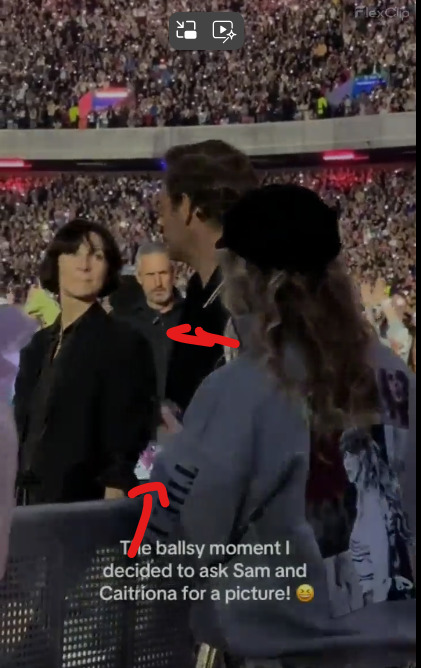
He does have an earpiece he is not wearing and something that looks like a badge attached lower than the usual attire.
For comparison purposes, this is how a security team member looked like, last year, in Minneapolis. Not the same country and not the same continent, but the guy made world headlines for being fired: he sang along with the crowd and asked a fan to take a pic of him in attendance, neglecting his job:

[Source: https://en.as.com/videos/security-guard-at-taylor-swift-concert-fired-for-asking-fan-to-take-photos-v/, August 24th 2023]
Many posted about Steve the minder from the Australian OL tour, this spring. This is Steve, back in March, on stage with S in Sydney, courtesy of SHW (https://www.tumblr.com/samheughanswife/744265708912951296/the-question-is-missed-but-its-about-claire-and):

Same attire. Same person? I think so, but I stand corrected, as always. After all, the participation of the cast was orchestrated by *** all along, no doubt about it.
Anyhow, pursed lips are also an old reflex:

[EIFF Festival, Edinburgh 2015, first public appearance of You Know Who]
Oh and uhm, I have got more. But right now, exit polls in ten minutes in my country, excuse me for hyperventilating and being an involved citizen, right?
[Later edit]: Here is a close-up (thank you, you know who you are 😘. You be the judge, but the resemblance is eerie. Nose, cheeks, moustache, forehead. Very strange:]

90 notes
·
View notes
Text

Isn't it glorious?
It’s here! I finally tackled my analysis of Key’s gold Gasoline era costume, worn in his music video for the song, photoshoots, a stage performance at the Inkigayo show, and a live performance at SM Town 2022. I’ll discuss everything from the fabrics used, the gloves, the shoes, complain about the zipper, talk about whatever the heck jumps are, break down all of the tiny little types of ornamentation (including the things I don’t actually know the name for) and more.
It’s scary in the best way. Buckle up. Grab some coffee or tea or vodka and a blanket.
I want to preface this by saying that this is going to be VERY long. I’ve polled my followers and nearly everyone said they want me to get as granular as I want. So I’m doing that. If that’s not your thing, here’s your exit ramp now. I get it. This is absurd.
You can also read it on my Twitter here. It actually has a LOT of bonus photos because they only allow me to have 30 on here, if you’re interested in seeing more. It may help clarify some things, as well.
Now then. Welcome to those who are left. Let’s begin!

Costumes by Dénicheur by Seo Seung Yeon
For his Gasoline era, Key has had four costumes designed and made by Dénicheur by Seo Seung Yeon, a Haute Couture Designer House that, among other things, makes elaborate costumes for Kpop performers. They’ve got an amazing Instagram portfolio to check out. They made him a gold and black costume for his G.O.A.T in the Keyland concert, the blue and white one for the Gasoline MV, this gold one, and a cream and gold beaded jacket for the 2023 SM Town Concert.
This fashion house’s trademark is intricately beaded, appliquéd…encrusted…costumes. I was able to get some high quality photos from some of you (thanks so much!) And the more I looked, the more I discovered.
If this were a piece of art (well, it is, but not in the same way) “Mixed Media” is what I’d call it. There are literally over twenty different types of beading techniques, appliqués, various types of sequins, trims, braids, rhinestones, chains, and more.
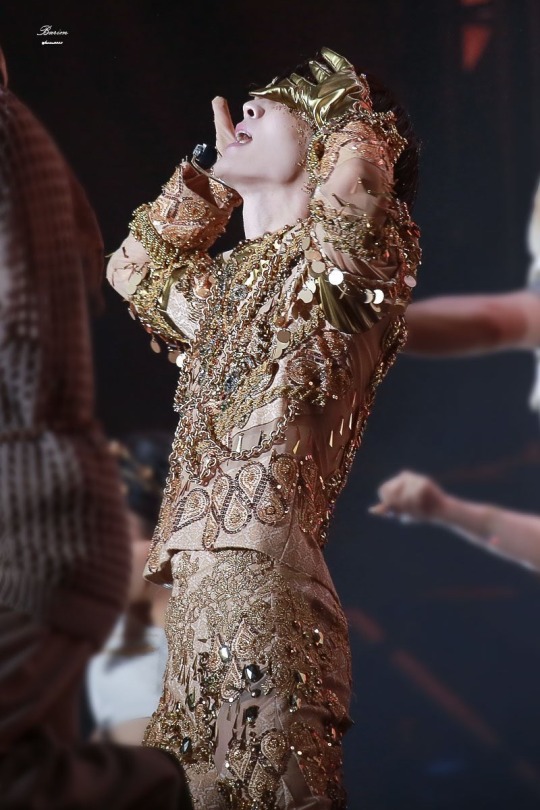
First, I’ll do an overview of the garments themselves, and then I’ll move on to the ornamentation.
The top (it’s not a jacket, it’s not really a shirt, it’s not a tunic. So I’m going with “top”) has a very boxy torso with exaggerated wide, padded shoulders. They’re completely squared. There are straight sleeves—not too slim, not too bulky. There’s a heavily ornamented oversleeve that reaches down to about his elbows and a “nude” colored full length under sleeve. It also has heavily ornamented cuffs at the bottom the sleeve. It has an exposed zipper up the center back that goes up into a short turtleneck collar. The collar and a portion of the lower neck back region are sheer with some beading and appliqués. There are sheer spirals around his arms and in chevrons on his front and scooping around to his back.

Just LOOK AT that masterpiece
The trousers are closely cut through the waist, hips, and thighs but become a bit wider at the knee. It looks like they were made full length but are always worn bunched up over knee high boots. They close at the center front with a very beautifully set fly zipper and flat trouser hook and bar. It’s so low profile that it wasn’t until I got some 4K images that I was even sure of where they closed. It was like he had been sewn in. I wrote a whole thread about it on Twitter that reads like a mystery novel, though I already spoiled the ending for you. Sorry.
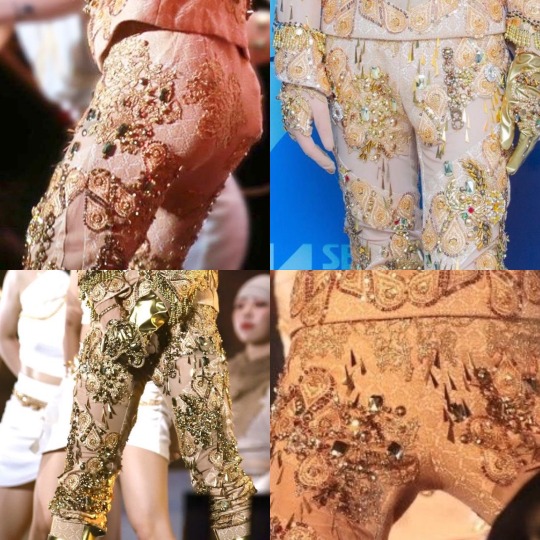
The top is made of what is probably a “nude” (aka specially dyed to his skin tone) base fabric to hold the structure, with the ornamentation stitched over top. The external stabilizing fabric is what appears to be some sort of jacquard, possibly silk.
Jacquard is a type of weave, where the fabric is made of long and short “up and down” stitches of sorts, to make a pattern. Because some of the time it uses longer “stitches” on top, it becomes more vulnerable to the fiber breaking and makes it become kind of “fuzzy” looking. This can be especially true if it’s a natural fiber that usually has less structural integrity than a synthetic one. I initially thought this had started to happen on Key’s rear, but after a very close zoom in, I think that’s just a bit of appliqué edge pulling up. I think maybe one of his mic packs is down there too, but I’m really not an expert in that. I did the research so you don’t have to, folks.
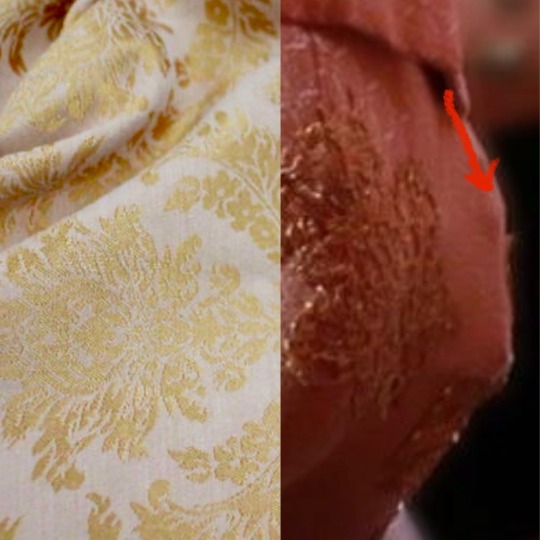
Left: A type of jacquard fabric. The shine comes from the longer top threads, contrasting with details of shorter threads. Right: Is it an applique or is it some snagged fibers? Ultimately, I think it's an applique edge.
Perhaps the most interestingly nerdy thing about jacquard is that it was originally made on a loom that led to the creation of computer programming by utilizing a sort of “binary code.” There were punchcards that showed the strands of fibers when to go up and down. Like “holes and not holes” in which to weave.
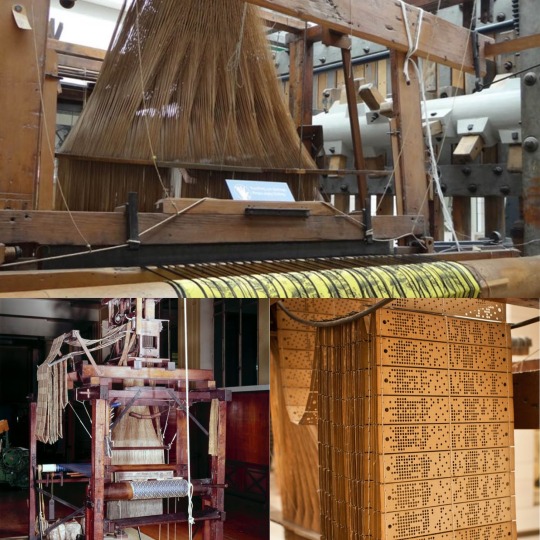
A Jacquard Machine Loom with punchcards that create the desired design on the fabric
It’s important to note that this fabric needs to have some stretch because it is also used to make his very tight fitting trousers. If it were not a stretch fabric, he wouldn’t be able to do this like THIS or…most things, really.
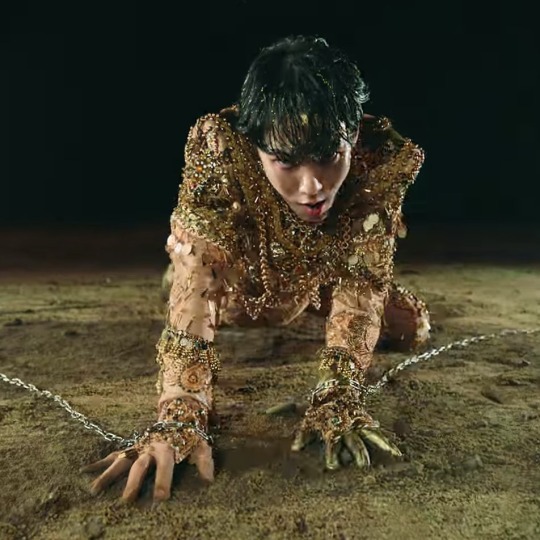
Even though the jacquard is stretchy, it has some structure to it. It’s used as a stabilizer in between the “flesh mesh” on the outer layer. (aka power net, stretch mesh... There are many names!) It forms the base on which the majority of the ornamentation is stitched.
Flesh mesh is a stretchy mesh fabric dyed to the performer’s skin color and is used to give the illusion that you’re seeing their skin, but it gives much more strength than just a cutout. I wrote a thread about flesh mesh and the importance of taking into consideration the performer’s actual skin tone when building them a costume here
In this case, flesh mesh allows for adornment of these areas, as well. It’s important to note that, even though it’s a separate layer over the base, it is “tacked” through all layers in a regular fashion so it doesn’t droop with the weight of all of the ornamentation.
There are also some parts that have metallic gold applied pieces. This was probably made of a beefy metallic spandex applied on top of the base rather than some solid pleather, due to way it behaves on the body. The latter would have been way too rigid in comparison to the rest of the fabrics.
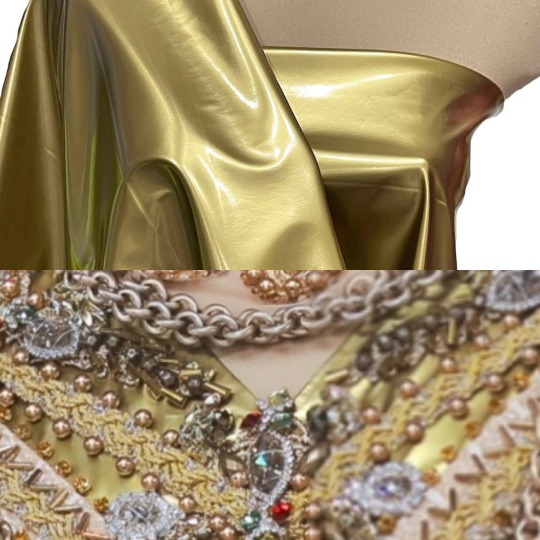
Heavy gold stretch spandex, forming a chevron on which to affix beads and other trims
Okay. Range of movement time. You know how I love discussing this. That’s because it’s the single most important aspect of costumes for dancers.
Let’s talk armpit gussets. They’re an American football shaped piece of fabric that is stitched in the armpit partially to the sleeve underarm, and partially to the torso underarm. It’s often made of a stretch fabric, but sometimes it’s out of the original “fashion fabric,” which is what we call the main garment fabric.

Gussets out of different fabrics under each underarm. You can see the gold bunch under his arm when it's at his side
It allows the performer to more easily move their arms above their chest and head to help keep the top from riding up. You can see in this photo, though, that it does bunch up a little when his arm is down, because of the extra fabric. It has to go somewhere when it’s not taut.
With this particular top, it’s interesting to note that, due to the asymmetrical decoration of his arms, one gusset is the gold stretch fabric and the other is the jacquard. That means that, either both fabrics have the exact same stretch, or his arms may be SLIGHTLY more limited on one side than the other. That’s fun! I really geeked out about this observation.
Often with jackets for dancers, they’ll have what are called “commodity pleats” around the center back shoulder area. They’re a sort of sneaky hidden accordion-like bit of fabric that stretches out during movement that may otherwise split the back open. Taemin uses them a LOT. But, since this top is so boxy, Key doesn’t need them in this instance. He already had the room he needed without any other accommodations.
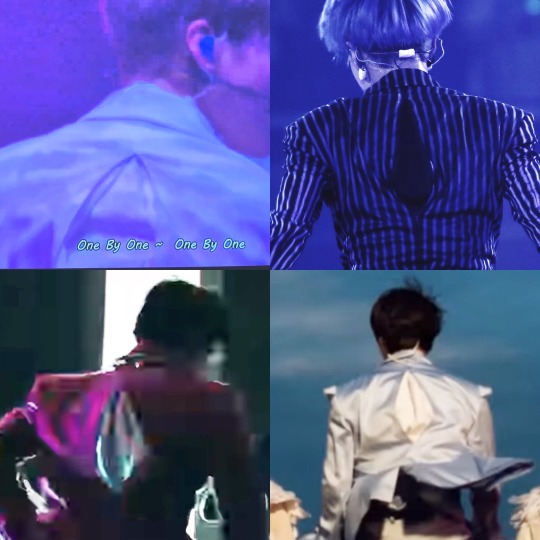
They put commodity pleats in the back of most of Taemin's closer fitting jackets. I wish they'd make them the same color as his jackets, though!
With Key’s trousers, we’ve already established that they’re made of a fabric with a decent amount of stretch. But since I can’t find many good photos of his bottom half, I’m unsure about if he also has “crotch gussets.”
By this point, I’m kind of notorious as being the “crotch gusset person.”
The following posts explain them in much more detail, but basically, they’re long triangular wedges that start in the trouser crotch and taper down to nothing in the inseam. These are often put in trousers of dancers when people need a better range of movement.
I wrote about this in detail regarding Taemin’s pleather pants he wore in his Metamorph concert, as well as all of SHINee in the Your Number dance video. You can find my posts on the subject here:(Metamorph) (Your Number)

Jinki rocking a black crotch gusset in SHINee's "Your Number" Performance Video (Black Version)
Gussets allow for extra room and movement when one is trying to do extreme leg movements like squatting. Unfortunately, I don’t have many good photos of his inseam. There’s so much going on with appliqués and piecing of mesh vs jacquard, it’s hard to tell. Part of the front half of his trousers is flesh mesh, swirling around them. The other parts are the jacquard, whereas the back is all jacquard.
I saw one photo which made me begin to wonder if the inseam is a little further forward than it could be, though. That could mean there IS a gusset. I’m really not sure...I don't have official visual confirmation, but now you know more about crotch gussets either way. You’re welcome.
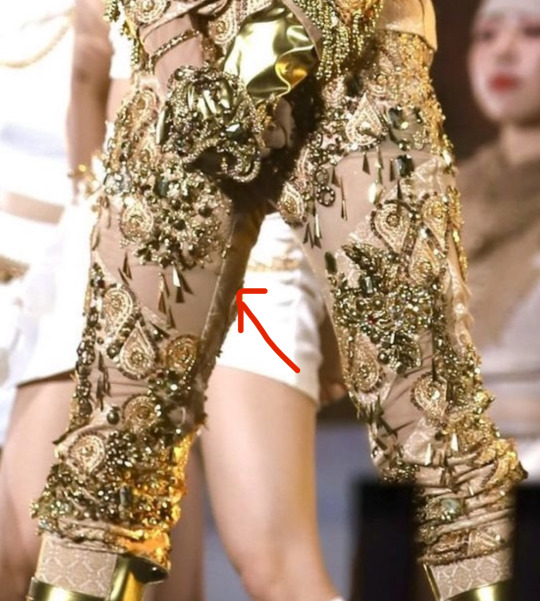
That seam line is up a bit more forward than usual. It really has me wondering, because that would happen if there was a gusset installed. Hmmmm.
Okay. Zipper education time. I apologize in advance. Things get spicy but I tried to tamp it down. The center back (abbreviated as “CB” in the industry) of the top has an exposed zipper. This means exactly what it sounds like: it’s exposed. You look at it, and it looks like there’s a zipper right there. It’s not hidden. Sometimes it’s a perfect match, and sometimes it’s “featured.” Exposed zippers actually become a trend every once in a while in everyday fashion.
I thought it was extremely interesting that, on this elaborate costume, they chose to use a zipper with metallic teeth on white “tape.” (The fabric on the sides of the teeth.) It was a huge disappointment for me, actually. I would have loved to have seen the zipper more carefully hidden like his fly was.

Hello, zipper. I see you loud and clear!
I have to comment a bit on what I view as the one flaw in this otherwise perfect costume. I will preface this by saying that I was not in the fitting room where this was conceived, and I don’t know about any extenuating circumstances and the reasoning behind this decision. But there a few things that I would have done differently regarding the zipper and back collar of this top if were to have made it.
But first: some zipper education. Besides exposed, there are center lapped, as well as regular lapped zippers. With the center lap, it’s like the fabric covers your zipper but you can pull the zipper down through it. Your hoodie probably has one. The regular lap zipper is more like your trouser fly in that there is one flap of fabric that covers the whole zipper, hiding it.
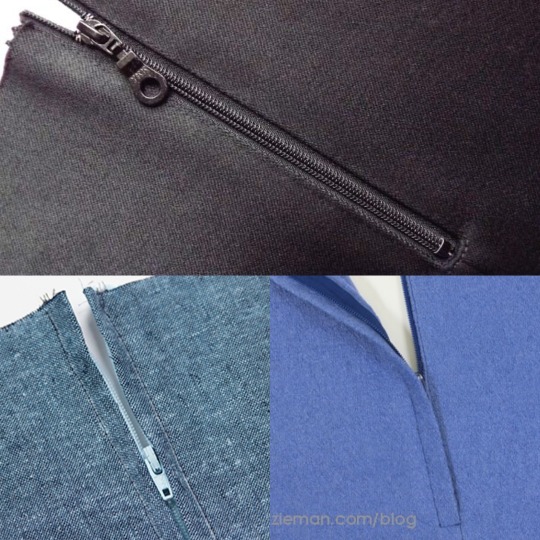
Top: Exposed. (Though it has a matching zipper and zipper tape.) Bottom Left: Center Lapped. Right: Regular Lapped.
Either of those types could have been used to make the zipper more discreet. I personally would have chosen to use a regular lapped zipper, which is less likely to get snagged than a center lapped zipper.
People have defended the exposed zipper by asking if it’s because it’s less likely to get caught. I very much get this argument, and, technically it’s right.
But, in my extensive experience, I don’t think I can recall a case of an exposed zipper in the back of a costume, quick change or no. It’s unattractive. (Not to mention a dead giveaway in a period garment!)
If it’s sewn well and tested, with the correct size lap and no loose fabric, it will work just fine. There should be a hook and eye at the top to make sure that it stays secure while dancing.
Part of being a good dresser is being methodical and purposeful, not frantically zipping something up in a way that is more prone to snagging. They keep their cool, perhaps taking a couple more seconds but ensuring that they pull it up smoothly. They use their fingers to block the overlap as they guide the zipper up.
(Random side note: I met a dresser once who preferred zippers be installed upside down for their quick changes. Hey, whatever works best for them! I wonder how they discovered that…)
I will also note that, as far as I’m aware, the only times he’s worn this costume, he didn’t need to get in or out of it quickly. I know that he wore it in the MV, the Inkigayo performance, and the photoshoot. He also performed at SM Town Tokyo 2022, though he had 11 songs during which to change between Bad Love and this. He never wore this look at his G.O.A.T. in the Keyland concert. Oh, and the collab with the Jinro frog. I’ll talk about that later.
So ultimately, all of the zipper quick change talk is for nothing. There COULD have been a chance that this was going to be worn during his concert, I suppose. But if not, in the end, I can find no reason that there needed to be an exposed zipper other than: they wanted it that way.
Sorry for that rant. I know that it was intense. I just…wish it were pretty. That’s all. I know it wouldn’t have bothered most people, but I personally think that the costume deserved better!
Well then. They arranged the symmetrical beaded appliqué motifs so they didn’t interfere with the center back line, so it wasn’t an issue being all chonky around the zipper.
Unfortunately, since the zipper was built into the neck with just the “stretch mesh,” it moves very differently than the rest of the top. It has a substantially weaker structural makeup and it can’t support itself the same, so it stretched at a different rate than the zipper on the solid fabric on the bottom. It kind of “bubbled” when he moved and it rode up.
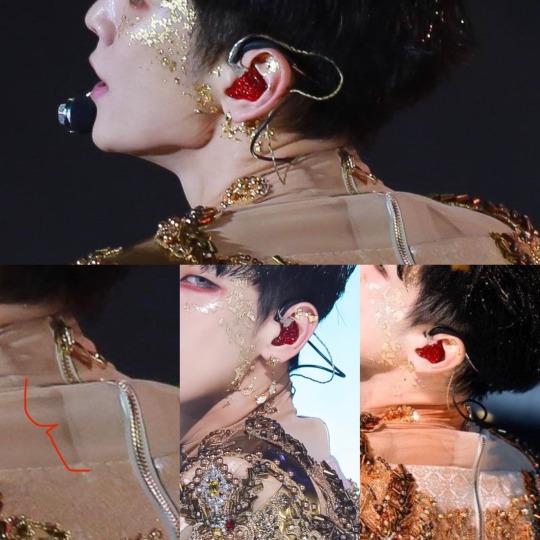
Showing the neck bubbling, and, on the bottom left photo, you can see that there is some sheer stabilizer to ensure that the zipper doesn't just tear out of the sheer net.
It couldn’t have been helped unless that whole back neck area had been backed with the solid nude base fabric. That’s what I would have done, personally. But using the stabilizer helped a bit. Without it, it may have not lasted a performance.
I don’t know why they did it that way, but the result was rather disappointing to me, especially considering the care that was taken with the rest of the garment.
Okay. End rant. The rest of the costume is EXQUISITE.
One more thing to note is that the zipper terminates about 4” above the top’s bottom hem. It is right around where his waist is. It was built that way to ensure that he was able to move his legs and hips comfortably without getting hung up anywhere.
His knee high boots were covered with the same peach jacquard as his top, as well as utilizing the gold fabric to serve as ornamental buckled straps.
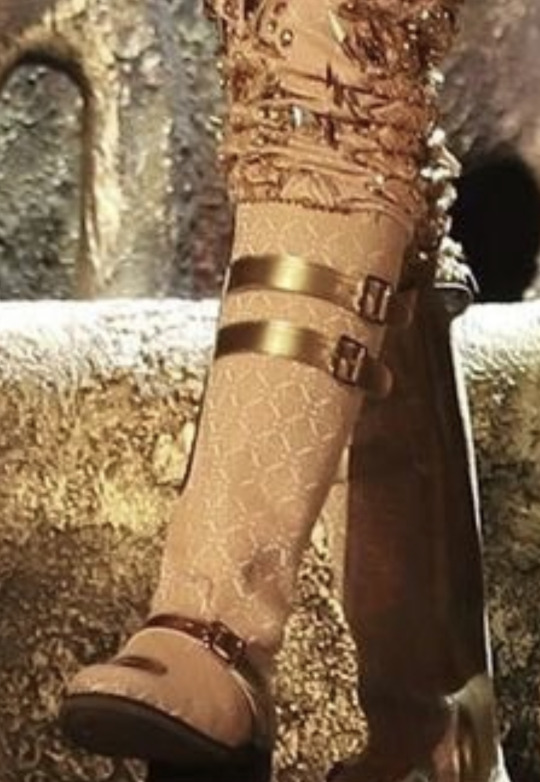
The stretch element of the jacquard is further showcased by the fact that it pulls over the boot toe smoothly, with little issue. A completely stable fabric wouldn’t be able to do that.
Now for the ornamentation. Oooooh boy. There are around twenty types of various adornments on this costume, and I thought I’d highlight some of them.
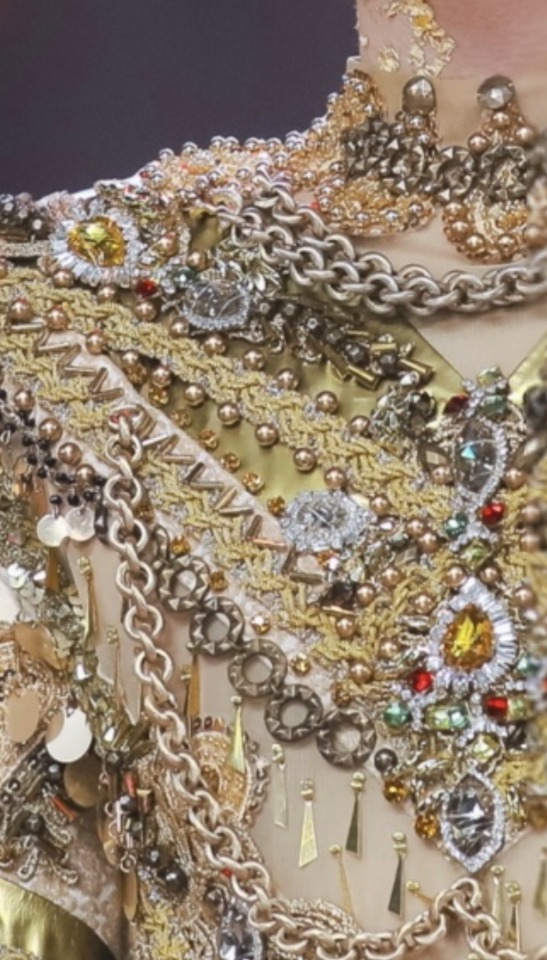
I can spy about 15 different types of ornamentation here alone.
Beaded appliques at the neckline
Heavy chains
Rhinestone appliques and/or individual rhinestone pieces
Bugle bead chevrons
Gold round beads
Yellow individual small rhinestones
Grey beads in between bugle beads
Gold and silver flat braid trim
Gold stretch fabric
Round flat decorative chain
Hanging paillettes
Dark seed beads with some of the paillettes
Gold dangling lil dudes
A sequined applique peeking out from behind a chain
Utilizing the main fabric as a chevon stabilizer as a design detail
About paillettes: these might actually be my favorites. They’re like “floppy sequins” that only have one hole at an edge. They’re made of a very lightweight plastic, so they’re virtually silent. If you wear a dress completely covered in paillettes, you’ll just hear a little rustle. In this case, his were mainly attached via dangly wires as fringe around the upper sleeves. There are a few other random instances throughout the garment where they’re stitched on individually. You can read more about paillettes in my post here.
Appliqués: There are at least three different types of appliqués in this costume:
Beaded
Lace
Sequined
Rhinestone
Appliqués are premade decorative pieces. It looks like someone hand beaded everything on the costume, but they were able to take a shortcut by using these. So no, contrary to what you might believe, there wasn't someone laboriously hand beading every single thing on to this costume.
It still takes FOREVER to invisibly stitch each motif on to the costume as well as, in this case, sometimes layer upon layer. A lot of them are attached to a net base, and in closeups, I saw how they trimmed the net away closely around the motifs.

On the top, we have the gold paisley sequined appliques. On his trousers, you can see the low profile lurex embroidered lace appliques. Bottom left, you can see the beaded and rhinestone applique. And on the right, beaded appliques. You can see that they're over flesh mesh so, when it's on Key, it just looks like he has a beaded collar.
The sequined, beaded paisley motifs are the most prominent and plentiful form of appliqués, focusing around the top’s cuffs and lower edge. They’re also heavily featured spiraling around the trousers. There are even some appliqués stitched across the seams of the trousers and top.
There are some huge, gorgeous bead and rhinestone appliqués, like this one on his right bicep that you can see in the photo above.
There’s also the Lurex lace (metallic threaded) embroidered appliqués that concentrate mostly on his trousers' waist and hips. It’s low profile without any bits that might snag the top while moving. They added a few jewels to it further down once it was no longer posing any danger to snags. There are also a few flat appliqués on his rear, so as to not make sitting uncomfortable but still be adorned.
Beads and gemstones: There are also individual beads and jewels both sewn and what appears to be discreetly glued on as accents. A popular adhesive we use for that sort of application is called E6000. It bonds pretty much everything from plastic, leather, metal, rubber, and wood. It’s like a slower acting super glue, but is more flexible.
You definitely need to use this in a ventilated area or, ideally, with a respirator. The fumes are no joke! There are little chevrons made out of long tubular metallic bugle beads that were probably glued instead of stitched on. There are also round bronze beads and gold rhinestones glued to the edges of the metallic fabric.
There are little dangling gold dudes, though I don’t know what they’re officially called. There are individual sew on rhinestones. There are circular decorative flat chains. There is gold beaded fringe at the wrists of the sleeves.
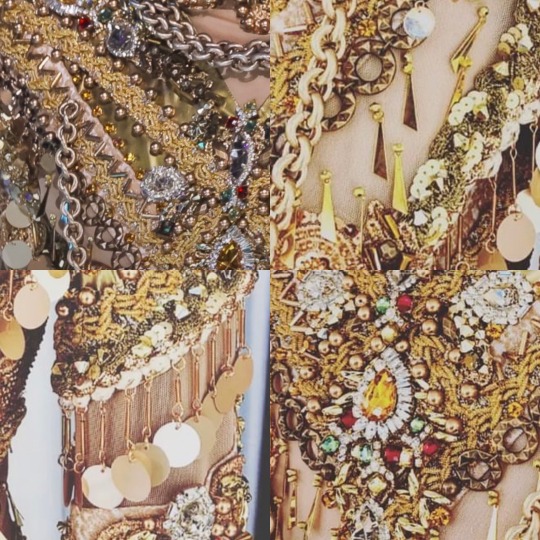
Top left: gold braid, beads and chains are heavily featured. Top right: the dangling gold dudes. I don't know what to call them. Bottom left: Paillettes, hanging on gold wires on the upper sleeve hem. Bottom right: Gemstones highlighting the center of the chest, with a whole organized, beautiful mess of braid, beads, etc.
There’s gold flat “braid” trim that also looks like it has a bit of silver in it to add dimension. It’s basically like a braided ribbon, often in metallic colors. It’s used a lot in military uniforms.
And there are a few other various random beads and trims that show up amongst the circus of adornment.
The layout of the overall design is asymmetrical, with left and right arms and legs that don’t match. However, the front of the top is completely symmetrical (which is extremely impressive) except for a few rampant rhinestones that intentionally deviate a bit. Here’s an abomination I made of the sleeves next to each other to see the asymmetry more clearly.

I THINK (not based on this photo but others that aren't Frankensteined together with different perspectives) that the sleeves are actually different lengths as well.
Something that I should cover is that with garments made out of a stretch fabric, like Key’s trousers in this case, stitching on something non-stretchy (like some appliqués) can be fraught. The appliqué can keep the fabric from stretching as much as it needs to accommodate a body in it, and it might tear off.
Sometimes, we need to stretch the fabric a bit as we sew on the motif so it will look normal when a leg is in it. It may look a bit puckered when it’s not being worn. The good news is that it appears that most of the motifs in this costume are on what is most likely a mesh backing, so they probably didn’t have to deal with that headache here!
Since the motif on the Jacquard fabric is pretty small, as well as the fact that some of the appliqués wrapped across the side seams, “pattern matching” wasn’t a big priority on this. However, it’s always preferable to keep the motifs at the same horizontal height. This is a REALLY small pattern, so it wouldn't matter terribly, plus the fact that it was so covered it can hardly be seen. There WAS a point on the right side seam where the pattern did match, but the fabric slightly torqued on the left so it didn’t. All in all, it wasn’t a big deal whatsoever. If it were a bigger print though, it could have been. I made a thread about pattern matching here. It's a subject I'm pretty passionate about!
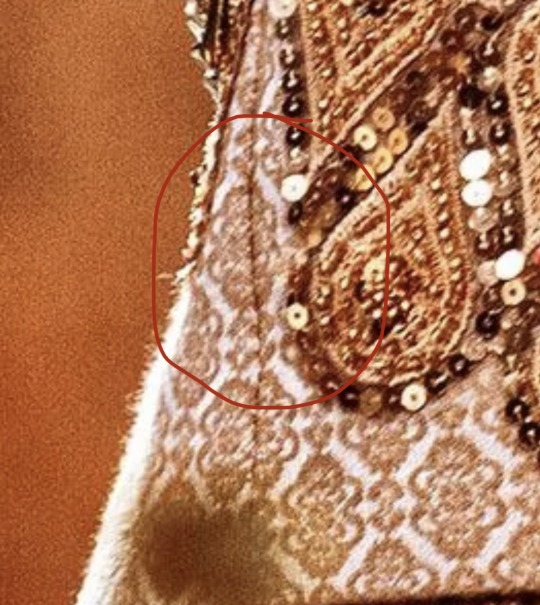
This side seam was cut so that, at a fixed point, the motif was all at the same level horizonatally at there was a part where the motif perfectly matched up to create one complete one. Because there are curves in the seam, it can't do that everywhere.
Now for a bit of a departure: SHINee and its members have done a few collabs over the years, dancing with the frog mascot from Jinro soju. SHINee did one for Don’t Call Me, Taemin did one for Move, and Key did one for Gasoline.
They dressed the frog up like Key, complete with jewels and chains! It was precious. SO GOOD. Watch it now. I also bring this up because that video was the resource I used to figure out where the gold chains on Key’s top were “tacked” (AKA stitched to keep it held down strategically.) It was a nice close-up view. Thanks, Jinro frog!
(Side note: I have made mascots before and it's ironic because they freak me out. I also refurbished a hot dog mascot that had gotten too gross after public appearances over a decade. My life is weird.)
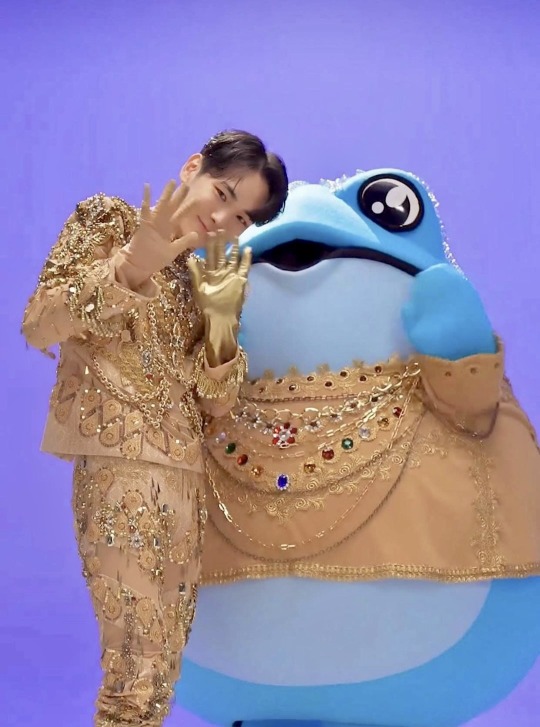
I love how scaled-back but accurate the frog's costume was.
Through the magic of the Jinro frog, I found the answer to the question “where were the chains tacked?” Here. Enough that they still have independent swing and look natural, but frequent enough to keep them from smacking him in the face. Based on the way they move, I think that is metallic coated plastic and not actual metal. Also, for safety's/comfortability's sake! You don't want to be thumped in the chest with every move.
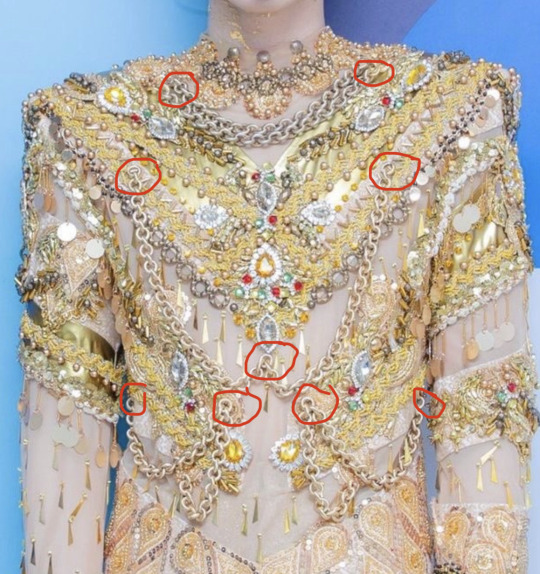
Here's where the chains were tacked
Someone asked me how much they thought this costume weighed. My answer?
I really have no idea…but probably not NEARLY as much as it looks? I'm like 99.9% sure the chains aren't actual metal. I’m not sure if the “jewels” are glass or plastic. The tiiiiiny “seed beads” and "bugle beads" are glass, but there aren’t enough that they would weigh a significant amount. There's a lot of gold braid on there that's very lightweight. A lot of what you see are layered appliqués with sequins and seed beads, which weigh nearly nothing. The dangling paillettes are just a light plastic.
For the garments themselves, as we’ve established, the are a few layers of fabric and mesh, which aren’t very heavy. Because of the “encrusted” nature of the ornamentation, of course, it still weighs a bit more than just a regular top, and is probably kind of rigid on the front. However, it’s not like he’s dancing around in chainmail.
Lastly, there are his gloves. His left one is made out of that heavy gold stretch fabric that was incorporated into the rest of his costume, and his right was also made out of a flesh mesh. From the way it behaves in this photo, it appears to be a much heavier mesh than the top and trousers.
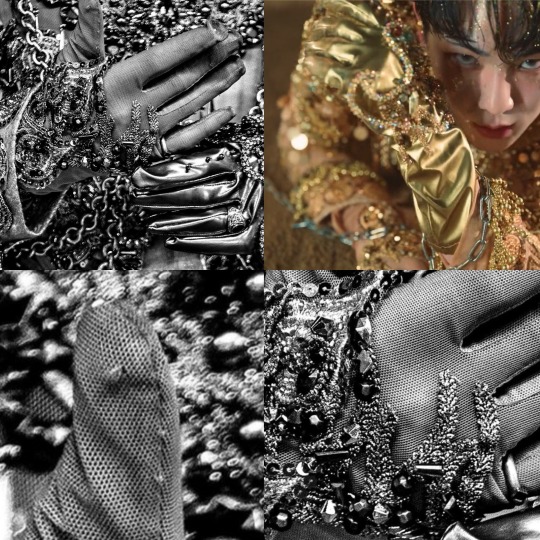
The right glove has thicker mesh that almost appears to have a natural fiber content that is getting snagged. It doesn't completely conform to the skin like a tight flesh mesh would.
The gloves are heavily ornamented with appliqués and beads. I’m going to guess that these were actually custom made for him, which is a big deal. I know very little about glove making, except it involves a TON of pieces to be done right. Gussets in between the fingers to make them slim and elegant and such. No Mickey Mouse hands here.
Stitching the ornamentation on to gloves is pretty difficult work. You either need a hand form and a curved needle or a very brave stitcher who uses their own hand as a form (palm up.) I haven’t done that for gloves, specifically, but I have been a “sacrificial hand” for other situations. I’m so calloused in most places, I don’t really feel much anymore!
There’s one more aspect to this costume that was seen in the intro for his Gasoline Inkigayo performance: the cloak. He didn’t wear it for very long, but it appears to button across his chest to the other shoulder with snaps underneath. The snaps keep the underlap from peeking out from…under the lap.
It looks like they might have had a wardrobe emergency here, because you can see that two of the three snaps were hastily stitched on with red thread. The ornamentation is asymmetrical, mostly focused on his right side. On his left shoulder, there is a decorative beaded “epaulette.” Those are the ornamental shoulder pieces you often see on military dress uniforms.
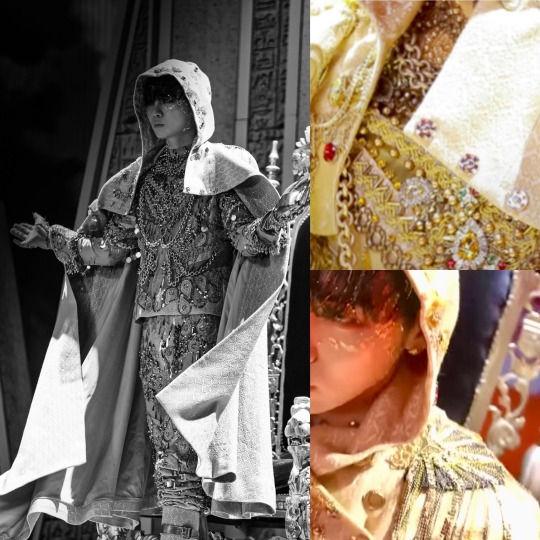
Left: The full cloak. You can see the facing on the inside edges, made of the same fabric as the outside. I'll write about that in a bit, and I'll show you a closer view later. Top right: The red thread holding on the upper snaps. Bottom right: Metallic epaulette.
It’s hooded and made out of the same jacquard fabric as the rest of his costume, and it has a satin lining the same color as the “fashion fabric.” It appears to be about calf length. One of the photos I found actually has a shot that shows the facing, the lining, and how the hem is done. Of course, I nerded out. It’s “self faced,” which means that there’s the same fabric that’s on the outside making up the “facing.” The facing is the first ten inches or so of the inside edge of the cloak. It makes a pretty transition from the outside to the inside, without a harsh switch to lining.
Then, there’s the hem.
While attached at the top, the hem of the lining and the outer fashion fabrics are allowed to “hang out” separately while on a dress form. Because fabrics stretch out at different rates (and it also changes by the direction they’re cut from the fabric, but that’s a whole different lesson…) it’s ideal for something like this to hang on a dress form and do its thing for a day or so.
In an ideal world, you’d have a fitting with your performer and you would mark a “level line” on them while they’re wearing the cloak (and also the shoes they will be wearing. Different shoes can change a lot!)
There are several different ways you can mark a hem. You can safety pin it up the way you want it, using a ruler measuring up from the floor to keep it even. But this can be awkward and clunky.
Or you can safety pin a “level line” and say that it’s, for instance, 18” off the ground, and you’d like the hem to be 16” off the ground. You’d draw a new hemline 2” down from the pins. It's the easiest way to know what's level and then decide exactly what you want to do later.
OR you can use what I call “the poofer” which is a little measuring stick on a tripod with chalk and a rubber squeezy ball that poofs chalk into a line at a set height, instead of dealing with pins. But sometimes the chalk doesn’t like to brush away, so that’s a bit of a risk in exchange for convenience.
First, let’s talk about hemming the outside cloak fabric. Because it may have stretched out unevenly, you may have wildly different hems lengths now that they’ve been “leveled.” Let’s say we’ll leave 6” of “hem allowance” to fold up into the garment so it can be lengthened later if we need to. You’ll trim the rest of it away. I can’t tell you how many times I’ve altered hem lengths on cloaks over the years! I'm always grateful to have extra.
You may want to finish the hem with a “serger” or “overlock” machine, which is the sewing machine that uses 3-4 threads to sew things, often stretch, together and kind of seals off the edges. It’s probably what stitches together the side seams of your t-shirt or hoodie or lounge pants or basically anything stretchy. It’s used to keep hems and the edges of fabrics inside garments from fraying. Sometimes people don’t do it, especially since it's inside, but it’s nice if you’re planning on altering it or if the fabric is really prone to fraying.
The cloak fabric is then thoroughly pinned and hand stitched up. There are many different sneaky stitches which grab a few threads at a time from the front of the fabric and are virtually invisible. Everyone has their favorites. My personal favorite is the “vertical hemming stitch” or “vertical blind hem.” I like it because it holds the inner hem and the outside of the cloak more tightly together than a lot of other styles. The “cross stitch” which is called the “blind catch stitch” here in this diagram is one of the most popular methods. However, I feel it can be a bit too loose some times and is more likely to be caught on something. The one downside of the vertical blind hem is that, if you pull it too tight, it’s more likely to show from the outside. It takes a very sensitive hand to get it right. The lining is usually slip-stitched to the cloak hem.

Once you’ve got your level line of your fashion fabric, it goes back on the dress form. I’m…not entirely sure I’ll do a good job explaining this because I work best with showing things with points and grunts. My apologies.
You mark the lining to match the level where the hem of the fashion fabric ends. You decide how far up from the bottom of the hem you want the lining to end (in this case, 4”.) So normally, you think you'd fold it up 4", right? Ha! You subtract two inches from that number. This means you’ll be folding up only two inches of lining. But, since we will be stitching it 4” up from the hem, that means there’s a floppy extra two inches. (Cue Advice.) What’s that for? Now I have to tell you about “jumps.”
Jumps are a sneaky trick. This method is used in suit coat hems and sleeve linings as well. Basically, they’re a way to give a little bit of wiggle room with the length of the lining to hem interaction.
After the fashion fabric is hemmed, you hand stitch the lining 4” up from the hem. You have two extra inches of lining. One extra inch of lining is pressed down so there’s an extra inch of “underlap". This photo (top right) showed me that they had done this to Key’s cloak. You can see it stretched out with the pressed line on the left, and it is folded over on the right.

Left: The "self fabric facing" at the center front inside of the cloak. Top right: The cloak hem showing the underside of the "jump" (left) and it down in its "resting" position (right). Bottom right: the "poofer." They're marking a level line.
If you want to get even MORE granular, that is considered a “soft press”, which means that the iron steams and very lightly rests on the fabric. A “hard press” is what it sounds like. Squish that lil dude and steam the heck out of it. That line is never gonna come out.
Okay. Enough of that. I can’t believe myself.
I could literally discuss this costume inch by inch, but I think I’ve covered it enough that you can peruse it yourself if you’d like and kind of know what you’re looking at.
I deeply admire and respect the, perhaps, 100+ hours of craftspersonship that it took to make this stunning costume. Don’t even ask me what it cost to make!
Do check out the Instagram of @denicheur.official where you can see other costumes they’ve worked on for groups like IVE, Enhypen, Stray Kids and more. They’ve got an amazing portfolio to drool over.
I hope you’ve gained an even greater appreciation for this gorgeous look, and the knowledge you’ve gained here can go forward with you as you enjoy future costumes! And thanks so much for sticking with me. I hope it was worth it!
#Shinee key#Key shinee#kpop#kpop costume#kpop costumes#Key#shinee#costume design#costume construction#costumes#gold costume#costume analysis#fashion analysis
58 notes
·
View notes
Text

Looking at exit polls from the Ohio abortion rights vote and interestingly when it’s broken down by gender and family, women with children are the most supportive of a right to abortion.
Kinda fucks up a lot of anti-abortion propaganda
57 notes
·
View notes
Text
Solving the Moderator's Trilemma with Federation

The classic trilemma goes: “Fast, cheap or good, pick any two.” The Moderator’s Trilemma goes, “Large, diverse userbase; centralized platforms; don’t anger users — pick any two.” The Moderator’s Trilemma is introduced in “Moderating the Fediverse: Content Moderation on Distributed Social Media,” a superb paper from Alan Rozenshtein of U of Minnesota Law, forthcoming in the journal Free Speech Law, available as a prepub on SSRN:
https://papers.ssrn.com/sol3/papers.cfm?abstract_id=4213674#maincontent
If you’d like an essay-formatted version of this post to read or share, here’s a link to it on pluralistic.net, my surveillance-free, ad-free, tracker-free blog:
https://pluralistic.net/2023/03/04/pick-all-three/#agonism
Rozenshtein proposes a solution (of sorts) to the Moderator’s Trilemma: federation. De-siloing social media, breaking it out of centralized walled gardens and recomposing it as a bunch of small servers run by a diversity of operators with a diversity of content moderation approaches. The Fediverse, in other words.
In Albert Hirschman’s classic treatise Exit, Voice, and Loyalty, stakeholders in an institution who are dissatisfied with its direction have two choices: voice (arguing for changes) or exit (going elsewhere). Rozenshtein argues that Fediverse users (especially users of Mastodon, the most popular part of the Fediverse) have more voice and more “freedom of exit”:
https://en.wikipedia.org/wiki/Exit,_Voice,_and_Loyalty
Large platforms — think Twitter, Facebook, etc — are very unresponsive to users. Most famously, Facebook polled its users on whether they wanted to be spied on. Faced with overwhelming opposition to commercial surveillance, Facebook ignored the poll result and cranked the surveillance dial up to a million:
https://www.nbcnews.com/tech/tech-news/facebook-ignores-minimal-user-vote-adopts-new-privacy-policy-flna1c7559683
A decade later, Musk performed the same stunt, asking users whether they wanted him to fuck all the way off from the company, then ignored the vox populi, which, in this instance, was not vox Dei:
https://apnews.com/article/elon-musk-twitter-inc-technology-business-8dac8ae023444ef9c37ca1d8fe1c14df
Facebook, Twitter and other walled gardens are designed to be sticky-traps, relying on high switching costs to keep users locked within their garden walls which are really prison walls. Internal memos from the companies reveal that this strategy is deliberate, designed to keep users from defecting even as the service degrades:
https://www.eff.org/deeplinks/2021/08/facebooks-secret-war-switching-costs
By contrast, the Fediverse is designed for ease of exit. With one click, users can export the list of the accounts they follow, block and mute, as well as the accounts that follow them. With one more click, users can import that data into any other Fediverse server and be back up and running with almost no cost or hassle:
https://pluralistic.net/2022/12/23/semipermeable-membranes/
Last month, “Nathan,” the volunteer operator of mastodon.lol, announced that he was pulling the plug on the server because he was sick of his users’ arguments about the new Harry Potter game. Many commentators pointed to this as a mark against federated social media, “You can’t rely on random, thin-skinned volunteer sysops for your online social life!”
https://mastodon.lol/@nathan/109836633022272265
But the mastodon.lol saga demonstrates the strength of federated social media, not its weakness. After all, 450 million Twitter users are also at the mercy of a thin-skinned sysop — but when he enshittifies his platform, they can’t just export their data and re-establish their social lives elsewhere in two clicks:
Mastodon.lol shows us how, if you don’t like your host’s content moderation policies, you can exercise voice — even to the extent of making him so upset that he shuts off his server — and where voice fails, exit steps in to fill the gap, providing a soft landing for users who find the moderation policies untenable:
https://doctorow.medium.com/twiddler-1b5c9690cce6
Traditionally, centralization has been posed as beneficial to content moderation. As Rozenshtein writes, a company that can “enclose” its users and lock them in has an incentive to invest in better user experience, while companies whose users can easily migrate to rivals are less invested in those users.
And centralized platforms are more nimble. The operators of centralized systems can add hundreds of knobs and sliders to their back end and twiddle them at will. They act unilaterally, without having to convince other members of a federation to back their changes.
Centralized platforms claim that their most powerful benefit to users is extensive content moderation. As Tarleton Gillespie writes, “Moderation is central to what platforms do, not peripheral… [it] is, in many ways, the commodity that platforms offer”:
https://yalebooks.yale.edu/book/9780300261431/custodians-of-the-internet/
Centralized systems claim that their enclosure keeps users safe — from bad code and bad people. Though Rozenshtein doesn’t say so, it’s important to note that this claim is wildly oversold. Platforms routinely fail at preventing abuse:
https://www.nbcnews.com/nbc-out/out-news/sexual-assault-harassment-bullying-trans-students-say-targeted-school-rcna7803
And they also fail at blocking malicious code:
https://www.scmagazine.com/news/threats/apple-bugs-ios-macos_new_class
But even where platforms do act to “keep users safe,” they fail, thanks to the Moderator’s Trilemma. Setting speech standards for millions or even billions of users is an impossible task. Some users will always feel like speech is being underblocked — while others will feel it’s overblocked (and both will be right!):
https://www.eff.org/deeplinks/2021/07/right-or-left-you-should-be-worried-about-big-tech-censorship
And platforms play very fast and loose with their definition of “malicious code” — as when Apple blocked OG App, an Instagram ad-blocker that gave you a simple feed consisting of just the posts from the people you followed:
https://pluralistic.net/2023/02/05/battery-vampire/#drained
To resolve the Moderator’s Trilemma, we need to embrace subsidiarity: “decisions should be made at the lowest organizational level capable of making such decisions.”
https://pluralistic.net/2023/02/07/full-stack-luddites/#subsidiarity
For Rozenshtein, “content-moderation subsidiarity devolves decisions to the individual instances that make up the overall network.” The fact that users can leave a server and set up somewhere else means that when a user gets pissed off enough about a moderation policy, they don’t have to choose between leaving social media or tolerating the policy — they can simply choose another server that’s part of the same federation.
Rozenshtein asks whether Reddit is an example of this, because moderators of individual subreddits are given broad latitude to set their own policies and anyone can fork a subreddit into a competing community with different moderation norms. But Reddit’s devolution is a matter of policy, not architecture — subreddits exist at the sufferance of Reddit’s owners (and Reddit is poised to go public, meaning those owners will include activist investors and large institutions that might not care about your little community). You might be happy about Reddit banning /r_TheDonald, but if they can ban that subreddit, they can ban any subreddit. Policy works well, but fails badly.
By moving subsidiarity into technical architecture, rather than human policy, the fediverse can move from antagonism (the “zero-sum destructiveness” that dominates current online debate) to agonism, where your opponent isn’t an enemy — they are a “political adversary”:
https://www.yalelawjournal.org/article/the-administrative-agon
Here, Rozenshtein cites Aymeric Mansoux and Roel Roscam Abbing’s “Seven Theses On The Fediverse And The Becoming Of Floss”:
https://test.roelof.info/seven-theses.html
For this to happen, different ideologies must be allowed to materialize via different channels and platforms. An important prerequisite is that the goal of political consensus must be abandoned and replaced with conflictual consensus…
So your chosen Mastodon server “may have rules that are far more restrictive than those of the major social media platforms.” But the whole Fediverse “is substantially more speech protective than are any of the major social media platforms, since no user or content can be permanently banned from the network and anyone is free to start an instance that communicates both with the major Mastodon instances and the peripheral, shunned instances.”
A good case-study here is Gab, a Fediverse server by and for far-right cranks, conspiratorialists and white nationalists. Most Fediverse servers have defederated (that is, blocked) Gab, but Gab is still there, and Gab has actually defederated from many of the remaining servers, leaving its users to speak freely — but only to people who want to hear what they have to say.
This is true meaning of “freedom of speech isn’t freedom of reach.” Willing listeners aren’t blocked from willing speakers — but you don’t have the right to be heard by people who don’t want to talk to you:
https://pluralistic.net/2022/12/10/e2e/#the-censors-pen
Fediverse servers are (thus far) nonprofits or hobbyist sites, and don’t have the same incentives to drive “engagement” to maximize the opportunties to show advertisements. Fediverse applications are frequently designed to be antiviral — that is, to prevent spectacular spreads of information across the system.
It’s possible — likely, even — that future Fediverse servers will be operated by commercial operators seeking to maximize attention in order to maximize revenue — but the users of these servers will still have the freedom of exit that they enjoy on today’s Jeffersonian volunteer-run servers — and so commercial servers will have to either curb their worst impulses or lose their users to better systems.
I’ll note here that this is a progressive story of the benefits of competition — not the capitalist’s fetishization of competition for its own sake, but rather, competition as a means of disciplining capital. It can be readily complemented by discipline through regulation — for example, extending today’s burgeoning crop of data-protection laws to require servers to furnish users with exports of their follow/follower data so they can go elsewhere.
There’s another dimension to decentralized content moderation that exit and voice don’t address — moderating “harmful” content. Some kinds of harm can be mitigated through exit — if a server tolerates hate speech or harassment, you can go elsewhere, preferably somewhere that blocks your previous server.
But there are other kinds of speech that must not exist — either because they are illegal or because they enact harms that can’t be mitigated by going elsewhere (or both). The most spectacular version of this is Child Sex Abuse Material (CSAM), a modern term-of-art to replace the more familiar “child porn.”
Rozenshtein says there are “reasons for optimism” when it comes to the Fediverse’s ability to police this content, though as he unpacked this idea, I found it much weaker than his other material. Rozenshtein proposes that Fediverse hosts could avail themselves of PhotoDNA, Microsoft’s automated scanning tool, to block and purge themselves of CSAM, while noting that this is “hardly foolproof.”
If automated scanning fails, Rozenshtein allows that this could cause “greater consolidation” of Mastodon servers to create the economies of scale to pay for more active, human moderation, which he compares to the consolidation of email that arose as a result of the spam-wars. But the spam-wars have been catastrophic for email as a federated system and produced all kinds of opportunities for mischief by the big players:
https://doctorow.medium.com/dead-letters-73924aa19f9d
Rozenshtein: “There is a tradeoff between a vibrant and diverse communication system and the degree of centralized control that would be necessary to ensure 100% filtering of content. The question, as yet unknown, is how stark that tradeoff is.”
The situation is much simpler when it comes to servers hosted by moderators who are complicit in illegal conduct: “the Fediverse may live in the cloud, its servers, moderators, and users are physically located in nations whose governments are more than capable of enforcing local law.” That is, people who operate “rogue” servers dedicated to facilitating assassination, CSAM, or what-have-you will be arrested, and their servers will be seized.
Fair enough! But of course, this butts up against one of the Fediverse’s shortcomings: it isn’t particularly useful for promoting illegal speech that should be legal, like the communications of sex workers who were purged from the internet en masse following the passage of SESTA/FOSTA. When sex workers tried to establish a new home in the fediverse on a server called Switter, it was effectively crushed.
This simply reinforces the idea that code is no substitute for law, and while code can interpret bad law as damage and route around it, it can only do so for a short while. The best use of speech-enabling code isn’t to avoid the unjust suppression of speech — it’s to organize resistance to that injustice, including, if necessary, the replacement of the governments that enacted it:
https://onezero.medium.com/rubber-hoses-fd685385dcd4
Rozenshtein briefly addresses the question of “filter bubbles,” and notes that there is compelling research that filter bubbles don’t really exist, or at least, aren’t as important to our political lives as once thought:
https://sciendo.com/article/10.2478/nor-2021-0002
Rozenshtein closes by addressing the role policy can play in encouraging the Fediverse. First, he proposes that governments could host their own servers and use them for official communications, as the EU Commission did following Musk’s Twitter takeover:
https://social.network.europa.eu
He endorses interoperability mandates which would required dominant platforms to connect to the fediverse (facilitating their users’ departure), like the ones in the EU’s DSA and DMA, and proposed in US legislation like the ACCESS Act:
https://www.eff.org/deeplinks/2022/04/eu-digital-markets-acts-interoperability-rule-addresses-important-need-raises
To get a sense of how that would work, check out “Interoperable Facebook,” a video and essay I put together with EFF to act as a kind of “design fiction,” in the form of a user manual for a federated, interoperable Facebook:
https://www.eff.org/interoperablefacebook
He points out that this kind of mandatory interop is a preferable alternative to the unconstitutional (and unworkable!) speech bans proposed by Florida and Texas, which limit the ability of platforms to moderate speech. Indeed, this is an either-or proposition — under the terms proposed by Florida and Texas, the Fediverse couldn’t operate.
This is likewise true of proposals to eliminate Section 230, the law that immunizes platforms from federal liability for most criminal speech acts committed by their users. While this law is incorrectly smeared as a gift to Big Tech, it is most needed by small services that can’t possibly afford to monitor everything their users say:
https://www.techdirt.com/2020/06/23/hello-youve-been-referred-here-because-youre-wrong-about-section-230-communications-decency-act/
One more recommendation from Rozenshtein: treat interop mandates as an alternative (or adjunct) to antitrust enforcement. Competition agencies could weigh interoperability with the Fediverse by big platforms to determine whether to enforce against them, and enforcement orders could include mandates to interoperate with the Fediverse. This is a much faster remedy than break-ups, which Rozenshtein is dubious of because they are “legally risky” and “controversial.”
To this, I’d add that even for people who would welcome break-ups (like me!) they are sloooow. The breakup of AT&T took 69 years. By contrast, interop remedies would give relief to users right now:
https://onezero.medium.com/jam-to-day-46b74d5b1da4
On Tue (Mar 7), I’m doing a remote talk for TU Wien.
On Mar 9, you can catch me in person in Austin at the UT School of Design and Creative Technologies, and remotely at U Manitoba’s Ethics of Emerging Tech Lecture.
On Mar 10, Rebecca Giblin and I kick off the SXSW reading series.
[Image ID: A trilemma Venn diagram, showing three ovoids in a triangular form, which intersect at their tips, but not in the middle. The ovoids are labeled 'Avoid angering users,' 'Diverse userbase,' 'Centralized platforms.' In the center of the ovoids is the Mastodon mascot. The background is composed of dead Twitter birds on their backs with exes for eyes.]
#pluralistic#cda#cda230#section 230#content moderation#federation#intermediary liability#mastodon#fediverse#protocols not platforms#activitypub#moderator's trilemma#agonism#subsidiary
94 notes
·
View notes
Text
MADHYA PRADESH & CHHATTISGARH Vidhan Sabha Election 2023
All Madhya Pradesh tumblr users(any age) willing to participate in exit poll cast your votes!!
19 notes
·
View notes
Text
Year-End Poll #24: 1973

[Image description: a collage of photos of the 10 musicians and musical groups featured in this poll. In order from left to right, top to bottom: Tony Orlando and Dawn, Jim Croce, Roberta Flack, Marvin Gaye, Paul McCartney and Wings Kris Kristofferson, Elton John, Billy Preston, Carly Simon, Diana Ross. End description]
More information about this blog here
*Turns my chair around so I can sit in it backwards*
So. You were just caught trying to cover up a major break-in into the Democratic National Committee headquarters in order to cement your reelection.
As I alluded to last poll, one major historical event I need to mention is the Watergate scandal. The actual break-in took place the previous year, but the resulting investigations and trials won't start to take place until this year -- after Nixon's reelection. However, there aren't many songs about the incident from this time, or at least not in the charts. Most of the songs protesting Nixon tended to focus on the war.
Speaking of the Vietnam War, 1973 does not mark the end of the war, but it does mark the beginning of the United States' exit. To bring it back to the music, one of the 60's polls included the Monkees' Last Train to Clarksville, a song that wasn't explicitly written about the war, but had the war projected onto it because it's a song about someone leaving home and not knowing when they're coming back. It seems fitting that one of the songs on today's poll is Tony Orlando and Dawn's Tie a Yellow Ribbon[...], a song that wasn't explicitly written about the war, but had the war projected onto it because it's a song about someone coming home and not knowing what his welcome will look like.
Soul music is continuing to have one of its golden ages, with artists like Roberta Flack and Marvin Gaye topping the charts. It's been a while since I talked about Billboard from the business side of things, but the explosion of this genre gives me a good excuse to do so. In 1973, the Billboard chart for R&B songs was changed from "Best Selling Soul Singles" to "Hot Soul Singles". This change may not sound that significant, but it becomes more notable when you see how often this title changes. This article goes more into depth about Billboard's complicated history when it comes to its representation of Black music.
Which reminds me, it's time to start talking about disco. It will reach the polls soon, I promise, but now feels like a good time to set the scene before we get to that point. As I mentioned in a previous poll, the disco scene really came out of soul. Especially Philly Soul, which had lush instrumentation that worked really well with the overall atmosphere of early disco. At this point in history, disco is still an underground subculture, and musically the line between it and soul music isn't that clear. Disco as its own genre of music that could be identified as such by the average listener will come later.
I don't usually talk about the formation of genres until they reach the charts, but I'm going to make an exception here. Because 2023 is the 50th anniversary of this genre, the genre has grown into a dominating musical force across the globe, and it's the only genre I actually studied in college.
In 1973, a Jamaican-American teenager named Clive Campbell (more widely known as DJ Kool Herc) and his sister, Cindy, started hosting parties out of their apartment in The Bronx, New York. These parties would play a lot of funk records, but he wouldn't just play them. Instead, he would play two copies of the same record on a turntable so he could extend the percussion section of the song, also called the break (which is where breakdancing comes from). This would lay the foundation for hip-hop, further expanded by artists like Grandmaster Flash and Afrika Bambaataa. All three of these men are still alive and I've linked interviews with some of them.
Hip-hop and rap are often used interchangeably, but there is a difference. Hip-hop exists both as a subculture and as a style of music. It incorporates art forms such as DJing, breakdancing, graffiti, beatboxing, rapping, and many other elements. That's why I said DJ Kool Herc helped set the foundation of hip-hop. Within early hip-hop culture, the MC was mostly there to bounce off of the DJ and keep the energy up. That isn't to discredit the difficult work of early MCs (trust me, if you were bad at it, the audience would let you know). Rap itself as an art from has a plethora of different artistic roots in Black culture, from scat singing in jazz, to various traditional West African storytelling techniques, to early 20th century gospel groups, to rhyme games, to Black radio DJs. The genre started to get more notice outside of the party scene as wordplay and flows started to expand further, especially as the first hip-hop groups started to form and the MCs became part of the "band". Like disco, hip-hop was still very much an underground subculture, but it would soon take over the nation.
It will be another 17 years before the first rap song reaches number 1 on the Billboard Hot 100 (Vanilla Ice's Ice Ice Baby). We won't see a rap song featured on these polls until 1995. But it's hip-hop's 50th birthday, and so much of modern American culture doesn't make sense without its involvement.
#billboard poll#billboard music#tumblr poll#1970s#1970s music#1973#tony orlando and dawn#jim croce#roberta flack#marvin gaye#paul mccartney#wings#kris kristofferson#elton john#carly simon#diana ross#billy preston
74 notes
·
View notes
Text
Austria Win The Second Semi Final's Eurovision Audience Poll
Austria Win The Second Semi Final's Eurovision Audience Poll
The Eurovision Audience poll is a collaboration between ESCXTRA.com, ESC Insight, The EuroTrip Podcast and BetEurovision. Volunteers asked the audience as they left the Liverpool Arena one question… “what was your favourite act?” These are the results.
Eurovision Audience Poll, Semi Final 2, 2023
Find out more at www.eurovisionaudiencepoll.com.

View On WordPress
2 notes
·
View notes